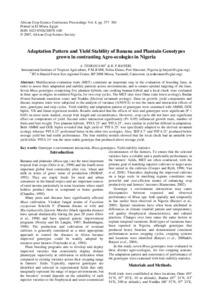| dc.contributor.author | Tenkouano, A. |
| dc.contributor.author | Baiyeri, K.P. |
| dc.date.accessioned | 2019-12-04T11:14:21Z |
| dc.date.available | 2019-12-04T11:14:21Z |
| dc.date.issued | 2007 |
| dc.identifier.citation | Tenkouano, A. & Baiyeri, K.P. (2007). Adaptation pattern and yield stability of banana and plantain genotypes grown in contrasting agro-ecologies in Nigeria. In 8th African Crop Science Society Conference, (pp. 377-384), 27-31 October, El-Minia, Egypt. |
| dc.identifier.uri | https://hdl.handle.net/20.500.12478/2736 |
| dc.description.abstract | Multilocation evaluation trials (MET) constitute an important step in the evaluation of breeding lines, in order to assess their adaptation and stability patterns across environments, and to ensure optimal targeting of the lines. Seven Musa genotypes comprising five plantain hybrids, one cooking banana hybrid and a local check were evaluated in three agro-ecologies in southern Nigeria, for two crops cycles. The MET sites were Onne (rain forest ecology), Ibadan (Forest-Savannah transition zone) and Nsukka (Derived savannah ecology). Data on growth, yield components and disease response traits were subjected to the analysis of variance (ANOVA) to test the main and interaction effects of sites, genotypes and crop cycles. Yield stability and adaptation pattern of genotypes were examined with AMMI, GGE biplot, YSi and linear regression models. Results indicated that the effects of sites and genotypes were significant (P < 0.05) on most traits studied, except fruit length and circumference. However, crop cycle did not have any significant effect on components of yield. Second order interaction significantly (P< 0.05) influenced growth traits, number of fruits and fruit weight. Two plantain hybrids, 'PITA 23' and 'PITA 25', were similar in yield but different in adaptation. Both AMMI and GGE biplot revealed that high yield of 'PITA 25' was specifically adapted to the derived savannah ecology whereas 'PITA 23' performed better in the other two ecologies. Also, 'BITA 7' and 'PITA 21' produced below average yield but had stable performance. The four stability models showed that the local check had an unstable low yield while 'PITA 14' was the most stable genotype that produced above average yield. |
| dc.format.extent | 377-384 |
| dc.language.iso | en |
| dc.publisher | African Crop Science Society |
| dc.subject | Genotypes |
| dc.subject | Musa |
| dc.subject | Yield |
| dc.subject | Environment |
| dc.subject | Plantains |
| dc.subject | Plantain Hybrids |
| dc.subject | Breeding |
| dc.title | Adaptation pattern and yield stability of banana and plantain genotypes grown in contrasting agro-ecologies in Nigeria |
| dc.type | Conference Paper |
| dc.description.version | Peer Review |
| cg.contributor.affiliation | International Institute of Tropical Agriculture |
| cg.coverage.region | Africa |
| cg.coverage.region | West Africa |
| cg.coverage.country | Nigeria |
| cg.authorship.types | CGIAR single centre |
| cg.iitasubject | Banana |
| cg.iitasubject | Genetic Improvement |
| cg.iitasubject | Plant Breeding |
| cg.iitasubject | Plant Genetic Resources |
| cg.iitasubject | Plant Production |
| cg.iitasubject | Plantain |
| cg.howpublished | Formally Published |
| cg.publicationplace | El-Minia, Egypt |
| cg.accessibilitystatus | Limited Access |
| local.dspaceid | 93717 |
| cg.targetaudience | Scientists |

